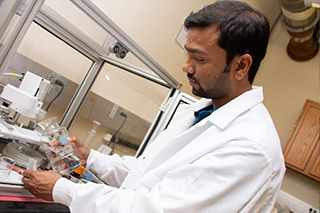News
Patient and Precise: Electromagnetic waves could capture the future of energy

From taking apart remote controls to finding the magnets inside motors as a child in Bangladesh, Ibrahim Azad has always been interested in smaller devices. Now Ibrahim, 33, has a chance to broaden his scope with his research on micro/nano devices.
Ibrahim is from Dhaka, the capital of Bangladesh, and has a bachelor's and master’s in applied physics, electronics, and communication engineering from the University of Dhaka. He came to USF in 2014 to work on a doctorate in electrical engineering. He and his wife were expecting their first child as he completed his dissertation and searched for jobs that would allow him to work on improving micro/nano devices that are important for applications such as infrared sensing and solar energy harvesting.
“When I started my science learning, I was eager to know how things work, and my questions about electronic things pushed me to learn more about electrical engineering,” he says.
One device is the antenna coupled diode rectifier (rectenna). One of the major applications for the rectenna is energy harvesting, which is generating clean energy from surrounding electromagnetic waves. Ibrahim found the rectenna could be the new technology for infrared detection that can address issues with current technologies. But, he says, there is still “lots of room to work on rectennae.”
His most valuable experiences at USF included discussing his work with friends and colleagues where “I learned how to be patient in your tough times.”
He plans to work in research and development in the United States for a few years and then take his expertise back home to guide engineering research in a university in Bangladesh, where he was previously a junior lecturer and where he said expertise is greatly needed because it is a developing country.
“I want to work in an environment where I can contribute to improve new technologies
for future generations,” Ibrahim said.
